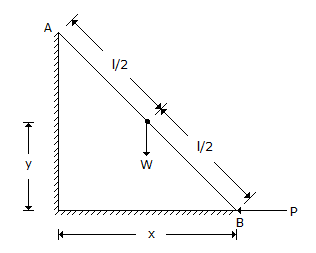Civil Engineering - UPSC Civil Service Exam Questions - Discussion
Discussion Forum : UPSC Civil Service Exam Questions - Section 17 (Q.No. 41)
41.
A ladder AB of weight W and length l is held in equilibrium by a horizontal force P as shown in the figure given above. Assuming the ladder to be idealized as a homogeneous rigid bar and the surfaces to be smooth, which one of the following is correct ?


Discussion:
3 comments Page 1 of 1.
Yashpal said:
7 years ago
Please explain the answer clearly.
Sultan khan said:
4 years ago
Fh=0. Fb=0
: P=Na. Nb=W.
(Torque) Tb=0,
:Na X Lcos@ =W X (L/2)Sinθ.
P=1/2WTanθ.
: P=Na. Nb=W.
(Torque) Tb=0,
:Na X Lcos@ =W X (L/2)Sinθ.
P=1/2WTanθ.
Adarsh said:
3 years ago
Total horizontal force=0 implies Na = P.
Total vertical force=0 implies W = Nb.
This Na and Nb are normal force about the walls A and B.
The resultant force of Na perpendicular to the ladder at A is = Na(cosθ).
The resultant force of W perpendicular to the ladder is= W(sinθ).
Therefore Total momentum about B is 0
Which implies; Na(cosθ)L - W(sinθ)L/2 = 0.
Na = p = W/2 (tanθ).
Total vertical force=0 implies W = Nb.
This Na and Nb are normal force about the walls A and B.
The resultant force of Na perpendicular to the ladder at A is = Na(cosθ).
The resultant force of W perpendicular to the ladder is= W(sinθ).
Therefore Total momentum about B is 0
Which implies; Na(cosθ)L - W(sinθ)L/2 = 0.
Na = p = W/2 (tanθ).
Post your comments here:
Quick links
Quantitative Aptitude
Verbal (English)
Reasoning
Programming
Interview
Placement Papers


